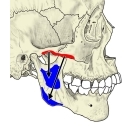咬 筋 ( こうきん、 英 : masseter muscle )
・ 概 要 |
・ 作 用 |
・ イラスト掲載サイ |
|
・ イラスト |
・ 神経 / 脈管 |
||
・ 起始 / 停止 |
・ Wikipedia |
![]()



・ 「 咬筋は強大な筋で、歯をかみ合わせると、体表からみることができ、かつ触れることができる。 」(船戸和弥のHP)
・一部は 耳下腺 の下部に位置する。また、場合によっては、浅部の起始部付近を 大・小頬骨筋 が横切って走る。
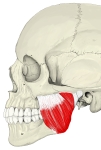 |
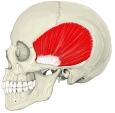
|
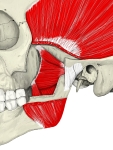
|
【 起 始 】: 浅 部 : 頬骨弓の前部・中部から起こり斜め後下方に走る。
深 部 : 頬骨弓の中部・後部、およびその内側面から起きて、ほぼ垂直に下行する。
【 停 止 】: 浅 部 : 下顎枝・下顎角の外面の咬筋粗面の下部
「 作用は 下顎骨 を引き上げて歯をかみ合わせる。 」( 船戸和弥のHP)
・ 神 経 : 咬筋神経 ( 下顎神経の「 咀嚼筋への枝 」の1つ )
・ 動 脈 : 動脈は 咬筋動脈( 顎動脈 の枝の1つ )あたりだと思われるが、それに言及している資料は見当たらない。
・ 静 脈 : ?
 |
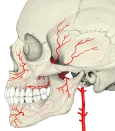
|
In human anatomy, the masseter [help 1] is one of the muscles of mastication. Found only in mammals, it is particularly powerful in herbivores to facilitate chewing of plant matter.[5] The most obvious muscle of mastication is the masseter muscle, since it is the most superficial and one of the strongest.
The masseter is a thick, somewhat quadrilateral muscle, consisting of two heads, superficial and deep. The fibers of the two heads are continuous at their insertion.
■ Superficial head ■
The superficial head, the larger, arises by a thick, tendinous aponeurosis from the temporal process of the zygomatic bone, and from the anterior two-thirds of the inferior border of the zygomatic arch. Its fibers pass inferior and posterior, to be inserted into the angle of the mandible and inferior half of the lateral surface of the ramus of the mandible.
【 語 句 】
・ mastication : 咀嚼 ・ herbivore : 草食動物 ・ facilitate : 容易にする ・ quadrilateral : 四辺形の ・ aponeurosis : 腱膜 ・ temporal process of the zygomatic bone : 頬骨の側頭突起 ・ zygomatic arch : 頬骨弓 ・ angle of the mandible :下顎角 ・ ramus of the mandible : 下顎枝
■ Deep head ■
The deep head is much smaller, and more muscular in texture. It arises from the posterior third of the lower border and from the whole of the medial surface of the zygomatic arch. Its fibers pass downward and forward, to be inserted into the upper half of the ramus as high as the coronoid process of the mandible. The deep head of the muscle is partly concealed, anteriorly, by the superficial portion. Posteriorly, it is covered by the parotid gland.
【 Innervation 】
Along with the other three muscles of mastication ( temporalis, medial pterygoid, and lateral pterygoid ), the masseter is innervated by the anterior division of the mandibular division (V3) of the trigeminal nerve. The innervation pathway is : gyrus precentralis > genu capsula interna > nucleus motorius nervi trigemini > nervus trigeminus > nervus mandibularis > musculus masseter.
The action of the muscle during bilateral contraction of the entire muscle is to elevate the mandible, raising the lower jaw. Elevation of the mandible occurs during the closing of the jaws. The masseter parallels the medial pterygoid muscle, but it is stronger and superficial fibres can cause protrusion.
【 語 句 】
・ coronoid process : 筋突起 ・ concealed : 隠れている ・ parotid gland : 耳下腺 ・ temporalis : 側頭筋 ・ medial pterygoid : 内側翼突筋 ・ trigeminal nerve : 三叉神経 ・ gyrus precentralis : 中心前回 ・ genu capsula interna : 内包膝 ・ nucleus motorius nervi trigemini : 3叉神経運動核 ・ bilateral : 左右両側の ・ contraction : 収縮 ・ mandible : 下顎骨 ・ protrusion : 突出



